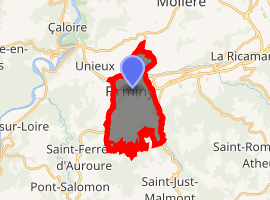Firminy
Firminy is a commune in the Loire department in central France.
Firminy | |
|---|---|
.svg.png) Coat of arms | |
Location of Firminy 
| |
 Firminy  Firminy | |
| Coordinates: 45°23′20″N 4°17′16″E | |
| Country | France |
| Region | Auvergne-Rhône-Alpes |
| Department | Loire |
| Arrondissement | Saint-Étienne |
| Canton | Firminy |
| Intercommunality | Saint-Étienne Métropole |
| Government | |
| • Mayor (2014–2020) | Marc Petit |
| Area 1 | 10.45 km2 (4.03 sq mi) |
| Population (2017-01-01)[1] | 17,135 |
| • Density | 1,600/km2 (4,200/sq mi) |
| Time zone | UTC+01:00 (CET) |
| • Summer (DST) | UTC+02:00 (CEST) |
| INSEE/Postal code | 42095 /42700 |
| Elevation | 446–800 m (1,463–2,625 ft) (avg. 468 m or 1,535 ft) |
| 1 French Land Register data, which excludes lakes, ponds, glaciers > 1 km2 (0.386 sq mi or 247 acres) and river estuaries. | |
It lies on the Ondaine River 8 mi. southwest of Saint-Étienne by rail.
History
The ancient name of the town was Firminiaco or Firminiacus (lit. "place of Firmin"). The name was first recorded in a 971 charter by the King of Burgundy.
Firminy had historically important coalmines known since the 14th century and extensive manufactures of iron, steel, and aluminum goods, including railway material, machinery and cannon. Fancy woolen hosiery was also manufactured.
Population
| Historical population | ||
|---|---|---|
| Year | Pop. | ±% |
| 1793 | 1,486 | — |
| 1806 | 1,821 | +22.5% |
| 1821 | 2,627 | +44.3% |
| 1831 | 3,779 | +43.9% |
| 1841 | 4,306 | +13.9% |
| 1851 | 5,374 | +24.8% |
| 1861 | 7,672 | +42.8% |
| 1872 | 10,422 | +35.8% |
| 1881 | 13,707 | +31.5% |
| 1891 | 14,511 | +5.9% |
| 1901 | 16,903 | +16.5% |
| 1911 | 19,580 | +15.8% |
| 1921 | 20,194 | +3.1% |
| 1931 | 21,365 | +5.8% |
| 1946 | 20,362 | −4.7% |
| 1954 | 21,161 | +3.9% |
| 1962 | 26,065 | +23.2% |
| 1968 | 24,924 | −4.4% |
| 1975 | 25,060 | +0.5% |
| 1982 | 24,113 | −3.8% |
| 1990 | 23,123 | −4.1% |
| 1999 | 19,297 | −16.5% |
| 2006 | 17,975 | −6.9% |
| 2015 | 16,839 | −6.3% |
Sights
Two historic churches from the 12th and 16th centuries are located here. The architect Le Corbusier designed a group of modern buildings, called "Firminy Vert", which includes the Saint-Pierre Church, a stadium, a cultural center, and an Unité d'Habitation.
References

- "Populations légales 2017". INSEE. Retrieved 6 January 2020.